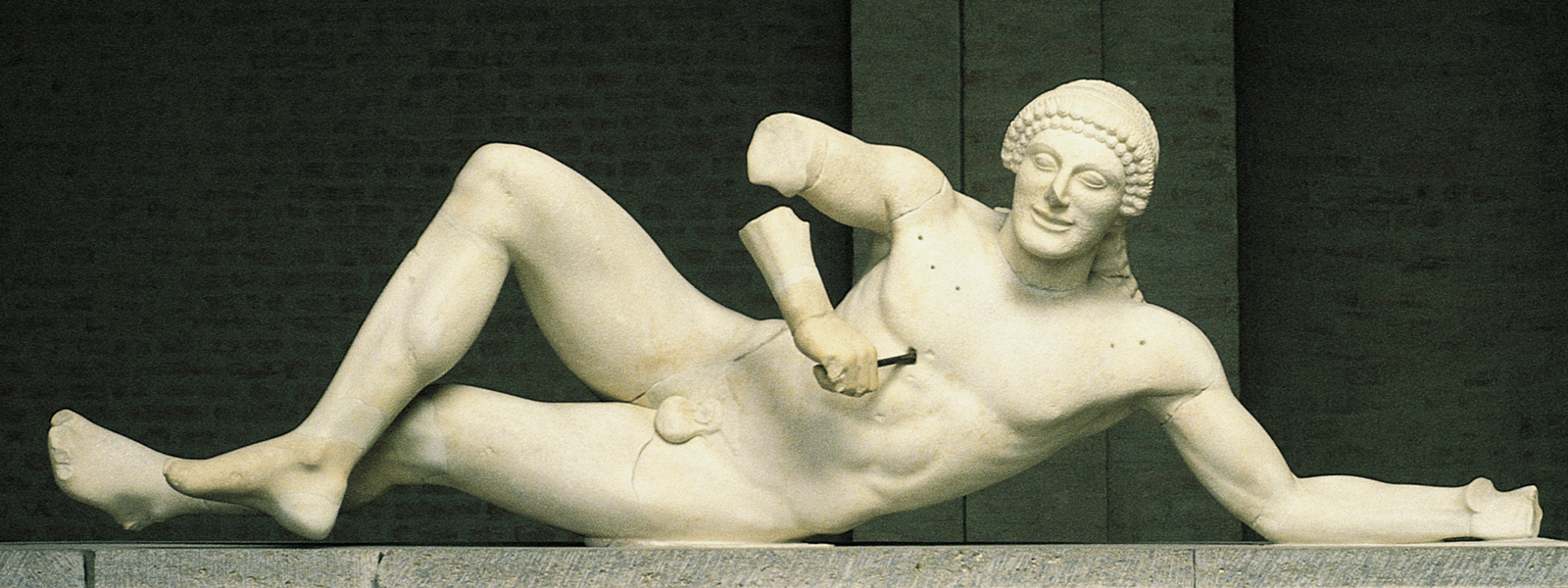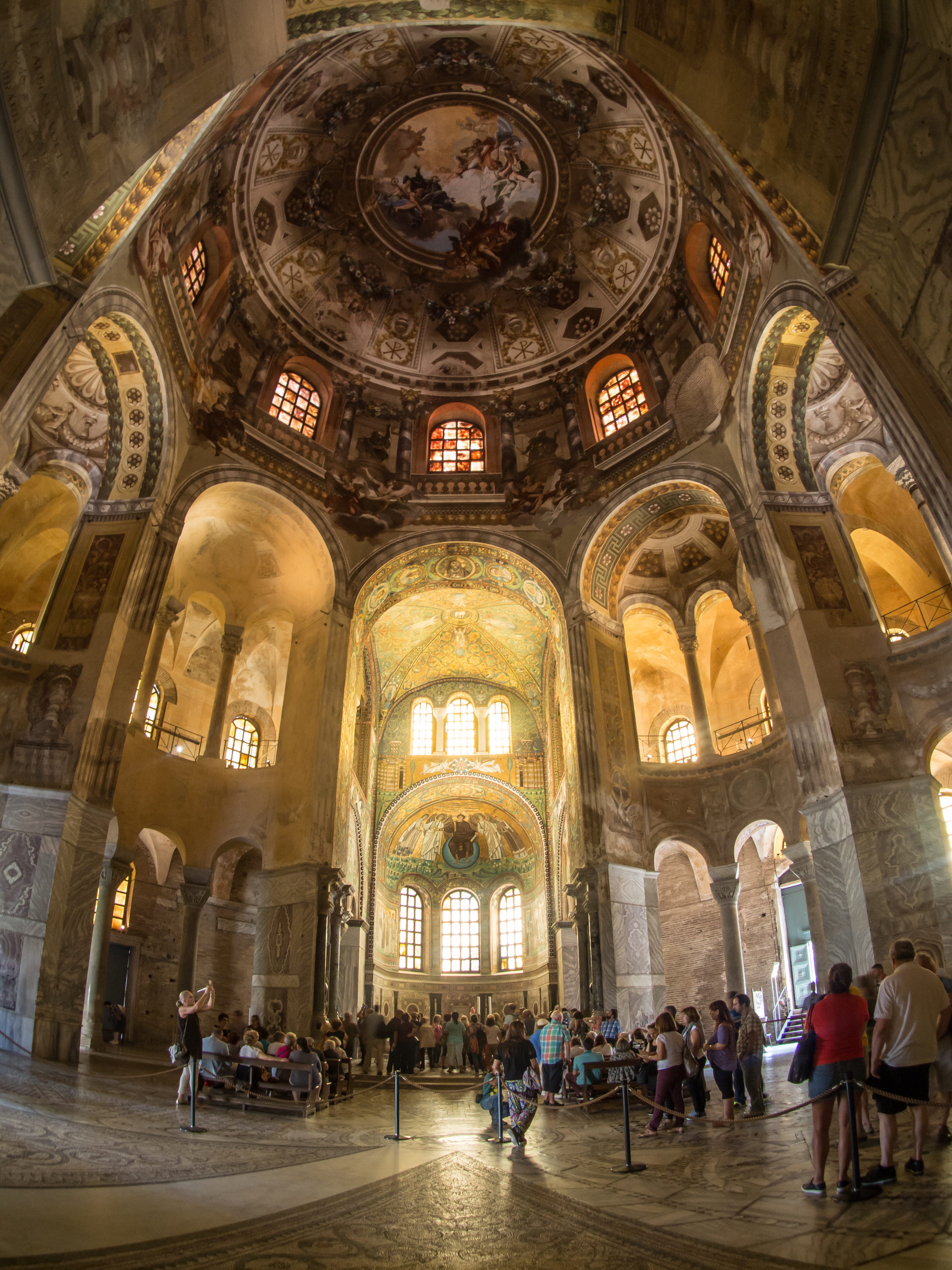Unit 2:
Faith & Empire
ARTS 1303, Art History 1
Prof. Morgan
Ancient Greece
Map of Ancient Greece


Topography of the Aegean Sea

The End of the Aegean Bronze Age
Rise of the Athenian Empire

Temple of Aphaia
Aegina, Greece
c. 500-490 BCE, Archaic Period

Artist’s rendering of the temple's facade


The Parthenon
Athens, Greece
5th century BCE, Classical Period
5:9
Artist’s rendering of The Parthenon atop the Acropolis in ancient Athens

Parthenon
Erechtheion
Propylaia
Theater of Herodes Atticus

Artist’s rendering of The Parthenon's facade
Recreation of the Athena Parthenos Statue from Athens

Greek Column ‘Orders’ or Styles


The Long-Lasting Acanthus Leaf
Dying Warriors, Temple of Aphaia
c. 490 & 480 BCE
Archaic Period


Kouros
c. 600 BCE
Archaic
Doryphoros
Polykleitos
c. 450-440 BCE
Classical
Apoxyomenos
Lysippos
c. 330 BCE
Late Classical




Kritios Boy
c. 480 BCE
Classical

Warrior
(aka Riace Warrior)
c. 460-450 BCE
Classical Period

Lost-Wax Casting Process
Once-Lost Greek Bronzes

Weary Herakles
Lysippos
c. 320 BCE
Late Classical

Laocoön
Early 1st century BCE
Hellenistic Period

Seated Boxer
c. 100-50 BCE
Hellenistic Period
Roman Art
Greco-Roman Art Overview
The Rise & Fall of Rome
Italian Peninsula, c. 500 BCE


Chimera d'Arezzo
c. 400 BCE
Etruscan


Portrait of a Boy
3rd century BCE
Etruscan

The "Uncanny Valley" Phenomenon

Simplified chart of the Uncanny Valley

The Uncanny Valley as experienced through AI

Roman Conquest of Italy
Head of an Old Man
mid-first century BCE
Late Republic

Torlonia Patrician
1st century CE copy
(80-70 BCE original)
Late Republic / Early Empire

Funerary Mask
c. 125 CE
Roman Period of
Egyptian Art History


Portrait of the Boy Eutyches
c. 100–150 BCE
Roman Period of
Egyptian Art History
Portrait of a Husband & Wife
c. 70-79 CE
Early Empire


West Wall of Room L of the Villa of P. Fannius Synistor at Boscoreale
c. 50-40 BCE | Late Republic
Pompeii, Italy

Cubiculum (bedroom) from the Villa of P. Fannius Synistor at Boscoreale
c. 40-50 BCE | Late Republic
Pompeii, Italy

Ixion Room, House of the Vetii
1st century CE | Early Empire
Pompeii, Italy



Examples of Ancient Roman Graffiti
Vibius Restitutus slept here alone and missed his darling Urbana
(Vico d’Eumachia, small room of a possible brothel)
Gaius Pumidius Dipilus was here on October 3rd 78 BC.
(in the Basilica)
A copper pot went missing from my shop. Anyone who returns it to me will be given 65 bronze coins (sestertii). 20 more will be given for information leading to the capture of the thief
(Street of the Theaters)
Love dictates to me as I write and Cupid shows me the way, but may I die if god should wish me to go on without you.
(in the Basilica)
Whoever loves, let him flourish. Let him perish who knows not love. Let him perish twice over whoever forbids love
(House of Caecilius Iucundus)
To the one defecating here. Beware of the curse. If you look down on this curse, may you have an angry Jupiter for an enemy
(House of Pascius Hermes; left of the door)

Augustus of Primaporta
c. 20 BCE
Early Empire

Revealed Polychromy of Augustus
The Myth of Marble
Forum of Augustus
Rome, Italy
c. 20 BCE | Early Empire


Artist's Rendering of the Forum


Floorplan of the Forum
Colosseum
Rome, Italy
c. 70-80 CE | Early Empire

Artist's Rendering of the Colosseum with Cutaway


View from Inside the Colosseum Ruins

Trajan's Column
Rome, Italy
115 CE
High Empire

Model of the Column's Spiral Staircase


Detail view of the column
Plaster casts of the column on display


Pantheon
Rome, Italy
125 CE
High Empire
Elevation view of the Pantheon


Aerial view of the Pantheon
Roman Concrete Applications




Dome (with Oculus)
Barrel Vault
Sequence of Groin Vaults
Groin Vault
Overhead plan view the Pantheon


Oculus 'spotlight' effect within the Pantheon
Aula Palatina (a.k.a. Basilica of Constanitine)
Tier, Germany | 310 CE, High Empire


Interior of the Basilica
Restored model of the Basilica

Plans for the Basilica

Byzantium
Intro to Byzantium
Map of Constantine's path to becoming Emperor

Spread of Christianity


Santa Costanza
Rome, Italy
c. 354 CE, Early Byzantine
Exterior of Santa Costanza

Interior of Santa Costanza with mosaic decoration

Reconstruction of Original Mausoleum Floor Plan

Floor plan & elevation of Santa Costanza


San Vitale
Ravenna, Italy
526-547 CE, Early Byzantine


Interior of San Vitale

Interior of San Vitale
showcasing elaborate
mosaics

The Octagonal Design of San Vitale


Santa Costanza overlay
East-West Stylistic Differences Emerge

Eastern
Western
The Great Schism of Christianity

A politically, culturally, & religiously divided Rome

The Remains of Rome, 526 CE
:format(webp):no_upscale()/cdn.vox-cdn.com/assets/4844976/europe_at_the_death_of_theodoric__ad_526__by_undevicesimus-d5tempi.jpg)
Justinian expansion of the Byzantine Empire


Hagia Sophia
Istanbul, Turkey
533-537 CE, Justinian
Artist's rendering of Old St. Peter's Basilica

Interior of Hagia Sophia

Drawing of the Old St. Peter's Basilica Interior


Floor plan of Hagia Sofia (w/ Santa Costanza overlay)


Artist's rendering of the original Hagia Sophia interior



Theodora & Her Attendants
San Vitale, Ravenna, Italy
c. 547 CE, Justinian
Mosaic of Justinian opposite of Theodora's within the church

Interior view of San Vitale
Making a Roman-Style Mosaic
Roman Naturalism vs Byzantine Abstraction


Four Icons from a Pair of Doors
Originally from Crete (possibly)
late-15th century CE
Late Byzantine

Paintings & Icons
The Baptism
(aka Epiphany)
late-15th century CE
Late Byzantine


The Qualities of Tempera vs Oil Paints
Harrowing of Hell
(aka Anastasis, or Resurrection)
late-15th century CE
Late Byzantine


The Gilding Process
Saint Nicholas
late-15th century CE
Late Byzantine






The Deësis Mosaic
Hagia Sophia, Istanbul, Turkey
13th century CE, Late Byzantine

Contextual view of the Mosaic

Detail from the Deësis Mosaic
Christ as Savior of Souls
Saint Clement, Ohrid, Macedonia
14th century CE, Late Byzantine

Evolution of Byzantine style







Islamic
Art
Hadith Frequently Quoted to Justify Violence:
Paradise is under the shadow of the swords.
In Full Context:
Do not look for a fight with the enemy. Beg God for peace and security. But if you do end up facing the enemy, then show endurance and remember that Paradise is under the shadow of the swords.
-Muslim ibn al-Hajjaj, 9th century CE, from Sahih al-Muslim
"Jihad" (جهاد) translates to "striving to achieve a goal"
Quranic Definition: Striving with one’s self and one’s money in the cause of God
If they leave you alone, refrain from fighting you, and offer you peace, then God gives you no excuse to fight them
-The Qur'an, An-Nisa 4.90
Expansion of the Islamic World

The Islamic Empire in 750 CE


Qubbat As-Sakhrah, قبة الصخرة (aka "Dome of the Rock")
Jerusalem, West Bank
c. 687-692 CE, Umayyad Caliphate
History & Beauty of Qubbat As-Sakhrah
Cross-Section of Quabbat As-Sakhrah Interior


The Kaaba, Al-Masjid al-Haram, Mecca, Saudi Arabia


Mosaic Mihrab
Isfahan, Persia (originally)
c. 1354 CE, Sarbedaran Period
Example of a full qibla wall with minbar & mihrab

Mosaic Patterns on Exterior of Qubbat As-Sakhrah

Examples of Islamic Geometric Tile Design



Making Islamic Geometric Designs
Muqarnas Ceiling from Shah Mosque, Isfahan, Iran


Quran Page
9th-10th cent CE
Abbasid Caliphate
The Beauty and Skill of the Handwritten Quran
Example of Arabic calligraphy

Symbols & logos using Arabic calligraphy



'Basmala' in Tuluth script
Al Jazeera logo
Emirates Airlines logo

'Basmala' in simple calligraphy
On Arabic Calligraphy
"Western" Islamic Calligraphy
Umayyad Mosque (aka "Great Mosque of Damascus")
Damascus, Syria
706-715 CE, Umayyad Caliphate

Aerial View of the Umayyad Mosque

Panoramic views of the Umayyad Mosque Courtyard


Example of a Hypostyle Spaces
Interior of a mosque in Riyadh, Saudi Arabia
Architectural Concept


Umayyad Mosque Interior


Mosque of Córdoba
Córdoba, Spain
8th-10th centuries CE, Abbasid/Córdoba Caliphate
Expansion of the Mosque of Córdoba over time

Phase 5
Phase 4
Phase 3
Phase 2
Phase 1
Phase 6
Street-level view of the Mosque of Córdoba

Courtyard of the Mosque of Córdoba

Interior of the Mosque of Córdoba

Qibla wall of the Mosque of Córdoba (minbar out of frame)

Mihrab of the Mosque of Córdoba

Gilded dome above the qibla wall

Evidence of cultural shifts inside the Mosque of Córdoba

Baroque chapel installed in the center of the former mosque

Baroque chapel installed in the center of the former mosque

Alhambra
Granada, Spain


text

text

text

text

text
Madrasa-mosque-mausoleum complex of Sultan Hasan
Cairo, Egypt

Selimiye Mosque
Edirne, Turkey
